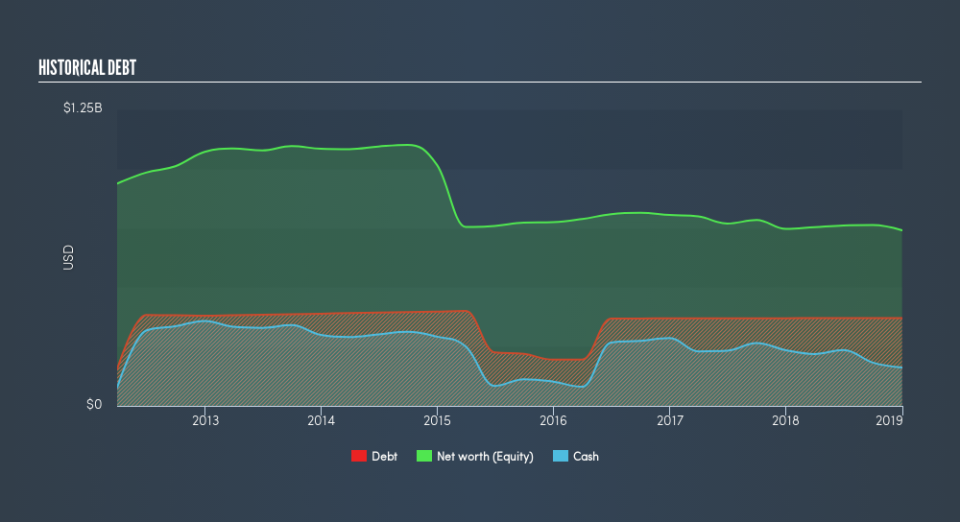How Financially Strong Is Kaiser Aluminum Corporation (NASDAQ:KALU)?

Want to participate in a short research study? Help shape the future of investing tools and receive a $20 prize!
Kaiser Aluminum Corporation (NASDAQ:KALU) is a small-cap stock with a market capitalization of US$1.7b. While investors primarily focus on the growth potential and competitive landscape of the small-cap companies, they end up ignoring a key aspect, which could be the biggest threat to its existence: its financial health. Why is it important? Assessing first and foremost the financial health is vital, since poor capital management may bring about bankruptcies, which occur at a higher rate for small-caps. Here are few basic financial health checks you should consider before taking the plunge. Though, given that I have not delve into the company-specifics, I’d encourage you to dig deeper yourself into KALU here.
How much cash does KALU generate through its operations?
KALU’s debt level has been constant at around US$370m over the previous year – this includes long-term debt. At this stable level of debt, KALU’s cash and short-term investments stands at US$162m , ready to deploy into the business. Moreover, KALU has generated US$150m in operating cash flow over the same time period, resulting in an operating cash to total debt ratio of 41%, signalling that KALU’s current level of operating cash is high enough to cover debt. This ratio can also be a sign of operational efficiency as an alternative to return on assets. In KALU’s case, it is able to generate 0.41x cash from its debt capital.
Can KALU pay its short-term liabilities?
Looking at KALU’s US$206m in current liabilities, the company has maintained a safe level of current assets to meet its obligations, with the current ratio last standing at 3.2x. However, a ratio greater than 3x may be considered by some to be quite high, however this is not necessarily a negative for the company.
Can KALU service its debt comfortably?
With a debt-to-equity ratio of 50%, KALU can be considered as an above-average leveraged company. This is not unusual for small-caps as debt tends to be a cheaper and faster source of funding for some businesses. We can check to see whether KALU is able to meet its debt obligations by looking at the net interest coverage ratio. A company generating earnings before interest and tax (EBIT) at least three times its net interest payments is considered financially sound. In KALU’s, case, the ratio of 6.23x suggests that interest is appropriately covered, which means that lenders may be less hesitant to lend out more funding as KALU’s high interest coverage is seen as responsible and safe practice.
Next Steps:
KALU’s high cash coverage means that, although its debt levels are high, the company is able to utilise its borrowings efficiently in order to generate cash flow. This may mean this is an optimal capital structure for the business, given that it is also meeting its short-term commitment. This is only a rough assessment of financial health, and I’m sure KALU has company-specific issues impacting its capital structure decisions. I suggest you continue to research Kaiser Aluminum to get a more holistic view of the small-cap by looking at:
Future Outlook: What are well-informed industry analysts predicting for KALU’s future growth? Take a look at our free research report of analyst consensus for KALU’s outlook.
Valuation: What is KALU worth today? Is the stock undervalued, even when its growth outlook is factored into its intrinsic value? The intrinsic value infographic in our free research report helps visualize whether KALU is currently mispriced by the market.
Other High-Performing Stocks: Are there other stocks that provide better prospects with proven track records? Explore our free list of these great stocks here.
We aim to bring you long-term focused research analysis driven by fundamental data. Note that our analysis may not factor in the latest price-sensitive company announcements or qualitative material.
If you spot an error that warrants correction, please contact the editor at editorial-team@simplywallst.com. This article by Simply Wall St is general in nature. It does not constitute a recommendation to buy or sell any stock, and does not take account of your objectives, or your financial situation. Simply Wall St has no position in the stocks mentioned. Thank you for reading.



